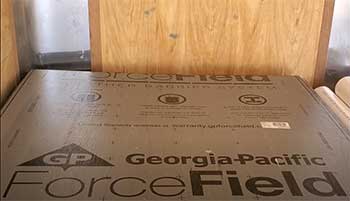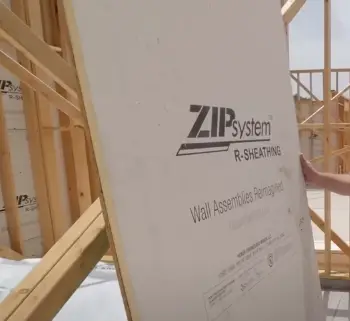When it comes to building wraps for exterior walls, two of the most popular options on the market today are ForceField OSB (oriented strand board) and ZIP sheathing.
But which one is the better choice for your next construction or remodeling project?
In this comprehensive guide, we’ll break down the pros, cons, features, and differences between ForceField OSB and ZIP sheathing to help you make an informed decision.
A Brief Comparison Table
| Aspects | ForceField OSB | ZIP Sheathing |
| Material | Oriented strand board + overlay | OSB or plywood + polymer overlay |
| Weather barrier | Moderate resistance | High resistance |
| Moisture resistance | Vertical drainage channels | Polymer overlay + taped seams |
| Air barrier | Yes with sealed seams | Yes with ZIP tape |
| Vapor permeable | Yes | No |
| Termite treatment | Yes | No |
| Installation | Standard + seal seams | ZIP tape at seams |
| Shear strength | Excellent | Standard OSB/plywood |
| Cost | $$ | $$$ |
What is Oriented Strand Board?
Before we dive into ForceField specifically, let’s start with a quick overview of OSB. Oriented strand board, commonly referred to as OSB, is an engineered wood product made from thin wood strands bonded together with adhesives. The wood strands are oriented lengthwise for increased strength.
OSB came into prominence as a sturdy, versatile, and cost-effective alternative to traditional plywood. It is widely used for sheathing, subfloors, roofs, and wall framing. Compared to plywood, the advantages of OSB include:
- Lower cost
- Lighter weight yet strong and stiff
- More easily available in larger panel sizes
- Superior performance in humid conditions
- Manufactured from fast-growing, sustainable tree farms
OSB does have some disadvantages as well. The major ones are that it does not handle impacts or edge swelling as well as plywood. The strands can also telegraph through thin finishes.
Now let’s look at how ForceField improves upon traditional OSB.
Introducing ForceField OSB
ForceField OSB is a proprietary structural wood panel created by Huber Engineered Woods. It enhances standard OSB in key ways to create a superior moisture-resistant, air-blocking building wrap.
Here are some standout features and benefits of ForceField OSB:

- Weather Defense: ForceField is engineered with a weather-resistant overlay on the exterior facing side. This enhances its water, air, and moisture resistance compared to traditional OSB.
- Strong Bond: The adhesive system binding the wood strands uses an advanced bonding technology to create a stronger OSB panel overall.
- Moisture Management: SmallGroove technology on the inner plies pulls any moisture that gets through to the outside. This protects the structural integrity of the wall.
- Air Barrier: With an air infiltration rate of 0.00 L/s/m2 at 1.57 psf, ForceField blocks drafts for improved energy efficiency.
- Shear Strength: The oriented wood strands and strong bonding result in excellent shear strength, stiffness, and rigidity.
- Termite Resistance: ForceField is treated to resist termites and fungal decay.
In summary, ForceField takes standard OSB to the next level for use as a sturdy sheathing that also provides enhanced moisture management and an air barrier when joints are sealed.
What is ZIP Sheathing?
ZIP System sheathing and tape is manufactured by Huber Engineered Woods, the same company that makes ForceField. But ZIP takes a different approach than ForceField.
ZIP sheathing is an OSB or plywood panel that is coated on the exterior face with a water-resistant polymer overlay. What makes ZIP unique is the integrated tape technology.
Once ZIP panels are installed on the exterior walls, simply attach ZIP tape to the seams between panels. The self-adhering tape seals out moisture and air. Installing ZIP sheathing and tape provides a continuous air, water, and weather barrier across the entire wall system.
Benefits of ZIP sheathing include:

- Weather Protection: The polymer overlay shields walls from rain and moisture. Taped seams prevent air and water infiltration.
- Time Savings: ZIP eliminates the need for housewrap and exterior sealing. Taping ZIP sheathing is faster than traditional building wrap installation.
- Air Tight: ZIP tape forms an airtight seal that blocks drafts and improves energy efficiency.
- Water Drainage: The overlapping tape allows any moisture to drain down the wall and out the bottom.
The advantages of ZIP make it appealing. But it comes at a higher cost than basic OSB.
Main Uses for ForceField and ZIP
Both ForceField and ZIP work well for wall sheathing, roof underlayment, and flooring underlayment. Their weather-resistant designs make them ideal for exterior use.
More specifically, here are the prime applications for each:
Best Uses for ForceField OSB
- Wall sheathing
- Gable ends
- Stair stringers
- Wind bracing
- Subflooring
- Soffits
ForceField is a great choice when you want enhanced moisture resistance along with the strength and cost advantages of traditional OSB. It meets code for structural and non-structural wall bracing. ForceField also holds up well when used as roof decking.
Best Uses for ZIP Sheathing
- Roof sheathing and underlayment
- Exterior wall sheathing
- Crawl spaces or basements
- Continuous insulation
ZIP system shines when installing an exterior weather barrier and taping the seams. Because it integrates the tape, it streamlines the weatherization process for roofs and walls. ZIP also works as an insulated foundation or crawl space wrap.
Pros and Cons of ForceField And ZIP
To recap, here are the key benefits and downsides of ForceField OSB and ZIP sheathing:
ForceField OSB Pros
- Cost-effective compared to plywood or other specialty boards
- Provides moisture resistance and air barrier with sealed seams
- Strong and stiff with excellent shear strength
- Treated to resist termites
- Qualifies as wall bracing
ForceField OSB Cons
- Requires additional time and supplies to seal seams
- Must overlap joints for drainage
- Not designed for open framing or continuous insulation
ZIP Sheathing Pros
- Integrated seaming tape provides immediate weather barrier
- Tape goes on quickly for significant labor savings
- Impermeable overlay prevents bulk moisture ingress
- Works for continuous insulation configurations
ZIP Sheathing Cons
- More expensive than standard OSB
- Loses some shear strength and rigidity benefits of OSB
- Forms vapor barrier that limits wall’s ability to dry
- No termite treatment
As you can see, each product has its advantages and best use cases. Choosing between them depends on your specific project requirements, budget, and performance priorities.
Which Is Better?
So when all factors are considered, is ForceField or ZIP the better residential building wrap?
For cost-conscious projects where structural integrity is paramount, ForceField OSB is hard to beat. It delivers moisture protection similar to ZIP, along with the strengths of traditional OSB, at a lower price point. Just be sure to factor in the added labor for sealing the seams.
ZIP sheathing justifies its higher cost through tremendous time and labor savings. For moisture prone areas or continuous insulation systems, the seamless weather barrier of ZIP is ideal. It streamlines the weatherization process.
Ultimately there is no universally “better” option. Each has advantages that make it optimal for certain applications. Carefully weigh the benefits of each against your specific needs and budget to decide if ForceField or ZIP is the right choice.
Either way, both ForceField and ZIP represent a major upgrade over standard OSB. The enhanced weather protection and air sealing will benefit any residential building project. Hopefully this overview gives you the information needed to select the best advanced sheathing for your upcoming construction or remodeling job.
Frequently Asked Questions (FAQ)
The main differences between ZIP and ForceField sheathing are:
ZIP uses an integrated synthetic weather barrier while ForceField relies on an OSB overlay.
ZIP’s attached tape provides immediate sealing while ForceField requires taping seams.
ZIP forms a vapor barrier and ForceField maintains vapor permeability.
ForceField matches traditional OSB’s strength and costs less than ZIP.
Yes, ForceField OSB is an excellent sheathing option. It improves on standard OSB by adding weather resistance, an air barrier when taped, and moisture management. ForceField provides enhanced protection with the strength and cost benefits of OSB.
In terms of weather protection, yes, ZIP system sheathing is better than traditional OSB. The integrated tape provides an immediate barrier while OSB requires separate housewrap and seam sealing. ZIP also excels for continuous insulation. But standard OSB is stronger, cheaper, and more vapor permeable than ZIP sheathing.
The main competitor to ZIP sheathing is ForceField OSB. Both are made by Huber Engineered Woods. Additional competitors include traditional housewrap systems with taped seams, proprietary polymer or foam sheathing alternatives, and insulated concrete form systems.
Final Thoughts
As this comparison shows, both products provide enhanced protection against moisture and air penetration compared to traditional OSB. The main differences come down to the weather barrier performance, vapor permeability, and installation method.
ForceField OSB alone provides a moderate weather barrier. Sealing the seams with tape improves resistance. ZIP uses a synthetic barrier and integrated tape for maximum weather protection out of the box.
In terms of moisture management, ForceField uses vertical grooves on the inner plies to channel water down and out. ZIP instead relies on preventing moisture ingress through the overlay and taped seams.
ForceField maintains vapor permeability, while ZIP forms a vapor barrier. ForceField also has termite treatment, whereas ZIP does not.
Installation wise, ZIP’s attached tape is faster than taping ForceField seams. But ForceField offers greater shear strength and rigidity thanks to its robustly bonded OSB core. It also comes in at a lower cost point than ZIP.
Overall, here is how the two options compare:
- ForceField provides an affordable, strong OSB building wrap alternative with enhanced moisture resistance. It requires additional time and labor to seal seams.
- ZIP delivers a high level of weather, air, and moisture protection out of the box. But it costs more and loses some structural advantages of traditional OSB.

